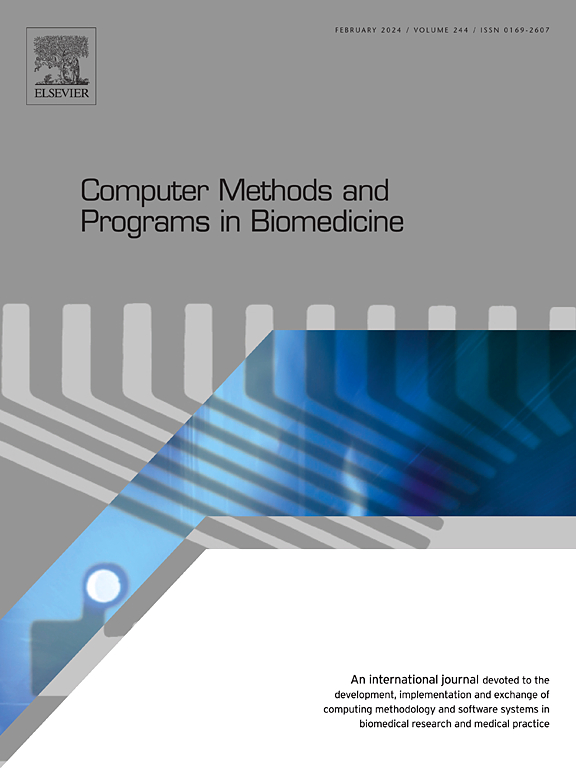基于机器学习方法的颅内动脉瘤计算流体动力学分析的患者特异性表观血液粘度预测模型的建立
IF 4.9
2区 医学
Q1 COMPUTER SCIENCE, INTERDISCIPLINARY APPLICATIONS
引用次数: 0
摘要
背景与目的在颅内动脉瘤的计算流体动力学(computational fluid dynamics, CFD)分析中,建立预测患者特异性表观黏度的模型是非常重要的。本研究的目的是建立一个模型,以预测患者特异性表观粘度从临床血液测试结果。方法对15例颅内动脉瘤患者当日进行血黏度、密度测定及血常规检查。将数据集按4:1的比例分为训练数据集和测试数据集。使用训练数据集构建以剪切率和12项血液测试(柔性模型)或红细胞压积(简单模型)为输入,测量表观粘度为输出的回归模型。采用和不采用线圈几何形状进行CFD分析,并对粘度模型进行了评估。结果柔性模型和简单模型预测的黏度均方根误差(RMSE)分别为0.136 mPa·s和0.226 mPa·s。CFD分析计算时均、空均速度和时均、空均壁面剪应力的RMSE分别为0.01 m/s和0.21 Pa。结论利用机器学习技术建立了基于剪切速率和血液检测项目预测患者特异性表观血黏度的回归模型。有一种可能性是,使用该预测模型,可以从个体患者的血液检测结果中高精度地预测患者特异性血液表观粘度。本文章由计算机程序翻译,如有差异,请以英文原文为准。
Development of patient-specific apparent blood viscosity predictive models for computational fluid dynamics analysis of intracranial aneurysms with machine learning approaches
Background and Objectives
A model to predict patient-specific apparent viscosity as a computational condition in computational fluid dynamics (CFD) analysis, which is used in research on intracranial aneurysms, is important. The purpose of this study was to develop a model to predict patient-specific apparent viscosity from clinical blood test results.
Methods
The data were from 15 patients with intracranial aneurysms in whom blood viscosity and density were measured and blood tests were performed on the same day. The dataset was divided into two, a training dataset and a test dataset at a ratio of 4:1. The training dataset was used in constructing regression models with shear rate and 12 blood test items (the flexible model) or hematocrit (the simple model) as input, and the measured apparent viscosity as output. CFD analysis was implemented with and without coil geometries, and the viscosity models were evaluated.
Results
The root mean squared error (RMSE) of viscosity predicted with the flexible model and the simple model was 0.136 mPa·s and 0.226 mPa·s, respectively. The RMSE of time-averaged and space-averaged velocity and time-averaged and space-averaged wall shear stress computed in CFD analysis were <0.01 m/s and <0.21 Pa, respectively.
Conclusions
Regression models to predict patient-specific apparent blood viscosity from shear rate and blood test items were constructed with machine learning. There is a possibility that, using this predictive model, patient-specific blood apparent viscosity can be predicted with high accuracy from the blood test results of individual patients.
求助全文
通过发布文献求助,成功后即可免费获取论文全文。
去求助
来源期刊

Computer methods and programs in biomedicine
工程技术-工程:生物医学
CiteScore
12.30
自引率
6.60%
发文量
601
审稿时长
135 days
期刊介绍:
To encourage the development of formal computing methods, and their application in biomedical research and medical practice, by illustration of fundamental principles in biomedical informatics research; to stimulate basic research into application software design; to report the state of research of biomedical information processing projects; to report new computer methodologies applied in biomedical areas; the eventual distribution of demonstrable software to avoid duplication of effort; to provide a forum for discussion and improvement of existing software; to optimize contact between national organizations and regional user groups by promoting an international exchange of information on formal methods, standards and software in biomedicine.
Computer Methods and Programs in Biomedicine covers computing methodology and software systems derived from computing science for implementation in all aspects of biomedical research and medical practice. It is designed to serve: biochemists; biologists; geneticists; immunologists; neuroscientists; pharmacologists; toxicologists; clinicians; epidemiologists; psychiatrists; psychologists; cardiologists; chemists; (radio)physicists; computer scientists; programmers and systems analysts; biomedical, clinical, electrical and other engineers; teachers of medical informatics and users of educational software.
 求助内容:
求助内容: 应助结果提醒方式:
应助结果提醒方式:


